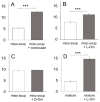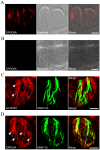Additive Effects of L-Ornithine on Preferences to Basic Taste Solutions in Mice
- PMID: 34836006
- PMCID: PMC8623908
- DOI: 10.3390/nu13113749
Additive Effects of L-Ornithine on Preferences to Basic Taste Solutions in Mice
Abstract
In addition to the taste receptors corresponding to the six basic taste qualities-sweet, salty, sour, bitter, umami, and fatty-another type of taste receptor, calcium-sensing receptor (CaSR), is found in taste-bud cells. CaSR is called the 'kokumi' receptor because its agonists increase sweet, salty and umami tastes to induce 'koku', a Japanese word meaning the enhancement of flavor characters such as thickness, mouthfulness, and continuity. Koku is an important factor for enhancing food palatability. However, it is not well known whether other kokumi-receptors and substances exist. Here, we show that ornithine (L-ornithine but not D-ornithine) at low concentrations that do not elicit a taste of its own, enhances preferences to sweet, salty, umami, and fat taste solutions in mice. Increased preference to monosodium glutamate (MSG) was the most dominant effect. Antagonists of G-protein-coupled receptor family C group 6 subtype A (GPRC6A) abolished the additive effect of ornithine on MSG solutions. The additive effects of ornithine on taste stimuli are thought to occur in the oral cavity, and are not considered post-oral events because ornithine's effects were confirmed in a brief-exposure test. Moreover, the additive effects of ornithine and the action of the antagonist were verified in electrophysiological taste nerve responses. Immunohistochemical analysis implied that GPRC6A was expressed in subsets of type II and type III taste cells of mouse circumvallate papillae. These results are in good agreement with those reported for taste modulation involving CaSR and its agonists. The present study suggests that ornithine is a kokumi substance and GPRC6A is a newly identified kokumi receptor.
Keywords: GPRC6A; L-ornithine; basic taste solutions; chorda tympani; electrophysiology; immunohistochemistry; kokumi; taste preference.
Conflict of interest statement
The authors declare no conflict of interest.
Figures









Similar articles
-
The flavor-enhancing action of glutamate and its mechanism involving the notion of kokumi.NPJ Sci Food. 2023 Jan 27;7(1):3. doi: 10.1038/s41538-023-00178-2. NPJ Sci Food. 2023. PMID: 36707516 Free PMC article. Review.
-
GPRC6A as a novel kokumi receptor responsible for enhanced taste preferences by ornithine.Elife. 2025 May 1;13:RP101629. doi: 10.7554/eLife.101629. Elife. 2025. PMID: 40309958 Free PMC article.
-
Supplementation effects of a kokumi substance, γ-Glu-Val-Gly, on the ingestion of basic taste solutions in rats.Chem Senses. 2022 Jan 1;47:bjac008. doi: 10.1093/chemse/bjac008. Chem Senses. 2022. PMID: 35512652
-
Umami taste responses are mediated by alpha-transducin and alpha-gustducin.J Neurosci. 2004 Sep 1;24(35):7674-80. doi: 10.1523/JNEUROSCI.2441-04.2004. J Neurosci. 2004. PMID: 15342734 Free PMC article.
-
Differential Effect of TRPV1 Modulators on Neural and Behavioral Responses to Taste Stimuli.Nutrients. 2024 Nov 12;16(22):3858. doi: 10.3390/nu16223858. Nutrients. 2024. PMID: 39599644 Free PMC article. Review.
Cited by
-
Testosterone acts through the membrane protein GPRC6A to cause cardiac edema in zebrafish embryos.Development. 2024 Dec 1;151(23):dev204390. doi: 10.1242/dev.204390. Epub 2024 Nov 29. Development. 2024. PMID: 39479956
-
Mouthfeel of Food and Beverages: A Comprehensive Review of Physiology, Biochemistry, and Key Sensory Compounds.Compr Rev Food Sci Food Saf. 2025 Jul;24(4):e70223. doi: 10.1111/1541-4337.70223. Compr Rev Food Sci Food Saf. 2025. PMID: 40625310 Free PMC article. Review.
-
The flavor-enhancing action of glutamate and its mechanism involving the notion of kokumi.NPJ Sci Food. 2023 Jan 27;7(1):3. doi: 10.1038/s41538-023-00178-2. NPJ Sci Food. 2023. PMID: 36707516 Free PMC article. Review.
-
GPRC6A as a novel kokumi receptor responsible for enhanced taste preferences by ornithine.Elife. 2025 May 1;13:RP101629. doi: 10.7554/eLife.101629. Elife. 2025. PMID: 40309958 Free PMC article.
References
-
- Ninomiya K. Science of umami taste: Adaptation to gastronomic culture. Flavour. 2015;4:13. doi: 10.1186/2044-7248-4-13. - DOI
-
- Blumenthal H., Barbot P., Matsuhisa N., Mikuni K. Dashi and Umami—The Heart of Japanese Cuisine. Cross Media; London, UK: 2009.
-
- Kodama S. On a procedure for separating inosinic acid. J. Tokyo Chem. Soc. 1913;34:751–757. (In Japanese)
MeSH terms
Substances
Grants and funding
LinkOut - more resources
Full Text Sources
Other Literature Sources

